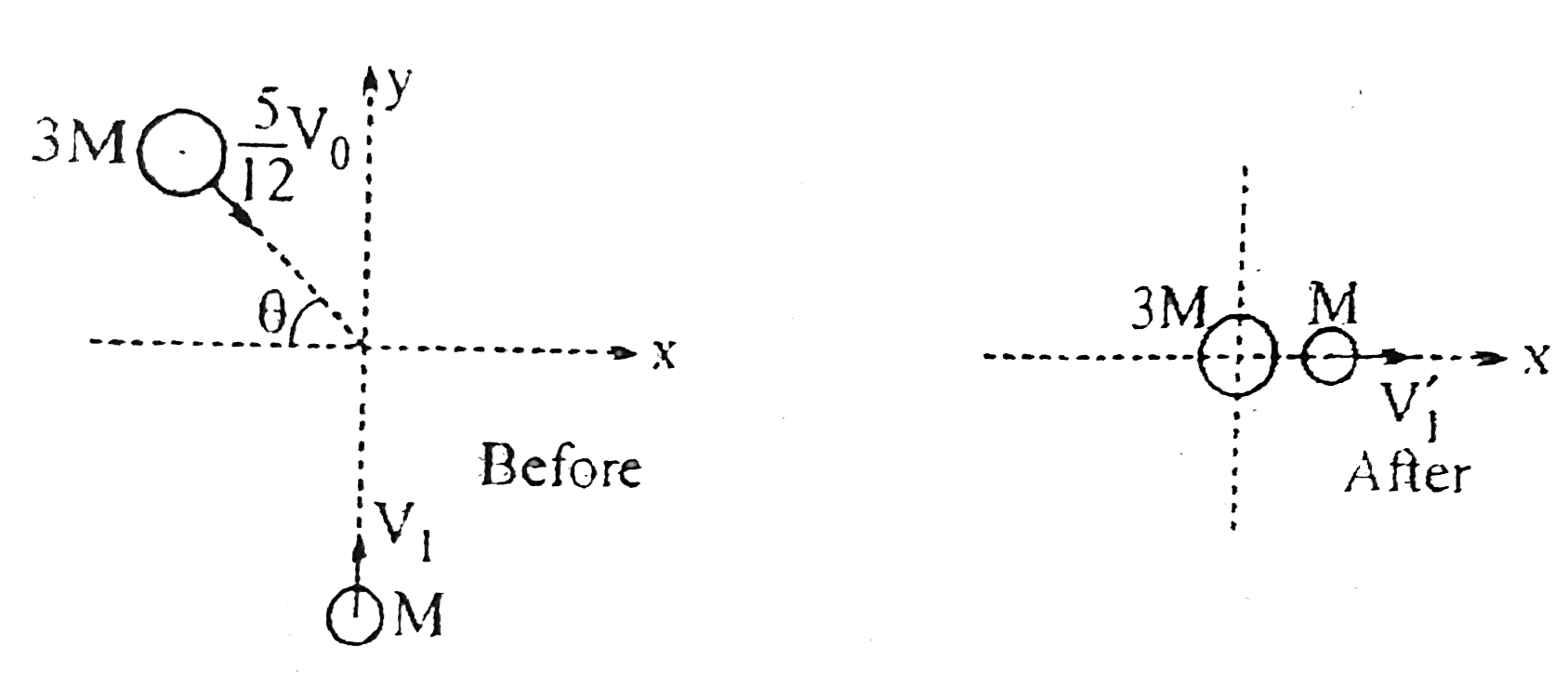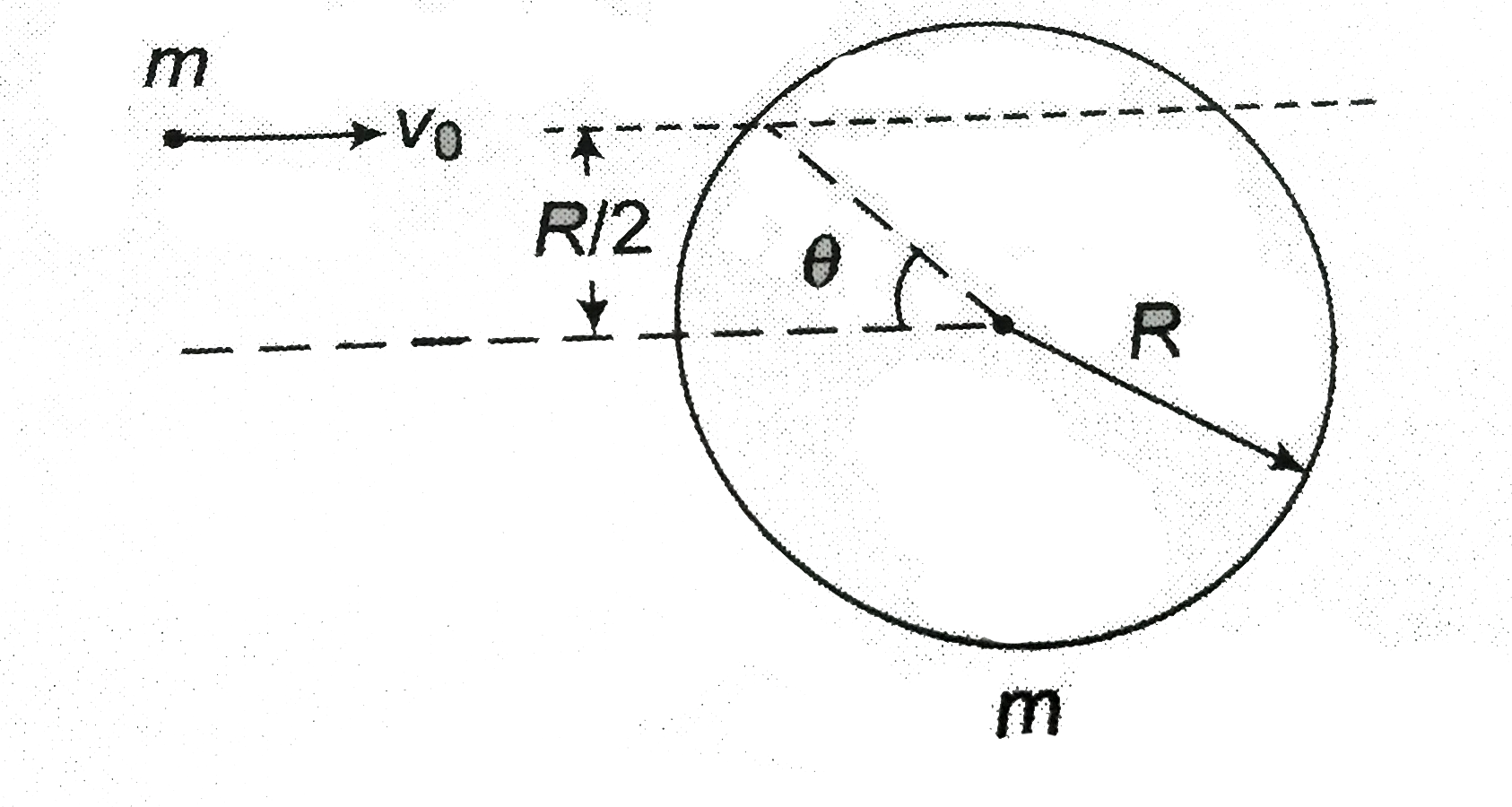Two masses M and 3M collide on a horizontal frictionless surface as shown. Before the collision the mass M has a velocity V1 in the y-direction. The mass 3M has a velocity (5/12)V0 making an angle thetha to the x-axis as shown. After the collision the mass 3M comes to rest and the mass M moves along the x-axis with the velocity V1 (Given sinthetha=3/5) Neglect gravity.

The speed V1 of mass M before collision is 34V0
The speed V1 of mass M before collision is V04
The speed V1 of mass M after collision is V02
The speed V1 of mass M after collision is V0
The correct Answer is:A, D
final momentum in y-axis is zero So MV1=(512V0sinθ)3M
V1=34V0 Along x-axis initial momentum = final momentum (512V0cosθ)3M=MV1
V1=V0
Topper's Solved these Questions
- BOOK - BANSALCHAPTER - MASTER PRACTICE PROBLEMEXERCISE - Subjective107videos
MASTER PRACTICE PROBLEM
- BOOK - BANSALCHAPTER - MASTER PRACTICE PROBLEMEXERCISE - Additional topic70videos
MASTER PRACTICE PROBLEM
- BOOK - BANSALCHAPTER - MASTER PRACTICE PROBLEMEXERCISE - Reasoning75videos
MASTER PRACTICE PROBLEM
- BOOK - BANSALCHAPTER - FLUID MECHANICSEXERCISE - PYQS AIEEE10videos
FLUID MECHANICS
- BOOK - BANSALCHAPTER - SEMICONDUCTORSEXERCISE - CBSE Question32videos
SEMICONDUCTORS
Similar Questions
In a given system of unit standard measurement of mass is 100 gm standard measurement of length is 200 cm and standard measurement of time is 5 sec 10 J energy in the given system of unit has value N, then value of N is
02:00View SolutionThe manifestation of band structure in solids is due to
View SolutionStatement-1: The numerical value (n)of a physical quantity is inversely proportional to size of unit (u) being used to measure it.
Statement-2:The magnitude of physical quantity does not change by changing the units.01:17View SolutionA cylinder of height 20m is completely filled with water. The velocity of effux of water (∈ms−1) through a small hole on the side wall of the cylinder near its bottom is
05:27View SolutionHow does the width of the depletion layer of a p-n junction diode change with decrease in reverse bias?
04:30View SolutionA mass m moving horizontal (along the x-axis) with velocity v collides and stricks to mass of 3m moving vertically upward (along the y-axis) with velocity 2v . The final velocity of the combination is
View SolutionA particle of mass m moving with velocity v0 collides with sphere of same mass at rest , as shown. If the surface of contact is smooth and the collision is elastic, find the velocities of particle and sphere after the collision.
 02:10View Solution
02:10View SolutionA uniform cube of mass m and edge a moves on a horizontal surface along the positive x-axis, with initial velocity v0. Then
View SolutionTwo masses each with mass 0.10kg are moving with velocities 3m/s along x axis and 5m/s along y-axis respectively. After an elastic collision one of the mass moves with a velocity 4ˆi+4ˆj . The energy of other mass after collision is x10 then x is
04:15View Solutionद्रव्यमान m का एक पिण्ड वेग u से चलता हुआ द्रव्यमान 3m के दूसरे स्थिर पिण्ड से प्रत्यास्थातः टकराता है | टक्कर के बाद दूसरे पिण्ड का वेग होगा :
02:55View Solutionmভরের একটি বস্তু x- অক্ষ বরাবর v বেগে গতিশীল অবস্থায়, 2v বেগে y-অক্ষ বরাবর গতিশীল 3m ভরের একটি বস্তুর সঙ্গে সংঘর্ষ ঘটাল এবং বস্তু দুটি যুক্ত হয়ে গেল | সংযুক্ত ভরটির অন্তিম বেগ হল-
05:15View SolutionTwo particles having masses m and 2m are travelling along x-axis on a smooth surface with velocities u_(1) and u_(2) , collide. If their velocities after collision are v_(1) and v_(2) , then the ratio of velocities of their centre of mass before ans impact is
View SolutionTwo particles having masses m and 2m are travelling along X-axis on a smooth surface with velocities u1andu2 collide. If their velocities after collision are v1andv2 then the ratio of velocities of their centre of mass before and after impact is
02:10View SolutionA billiard ball of mass M , moving with velocity v1 collides with another ball of the same mass but at rest . If the collision is elastic , the angle of divergence after the collision is
02:26View SolutionA particle of mass m moving with velocity u collides elastically with a particle of mass 3m at rest. After collision the heavier particle moves with velocity.
03:22View Solution

